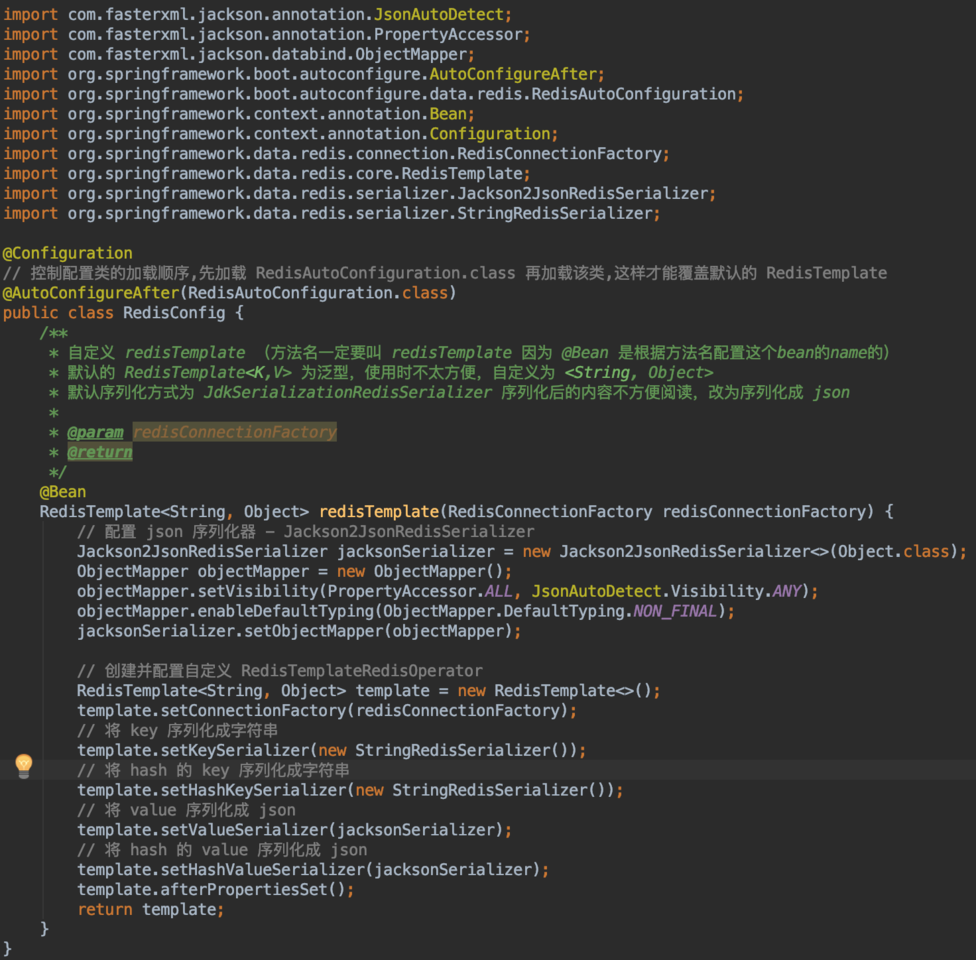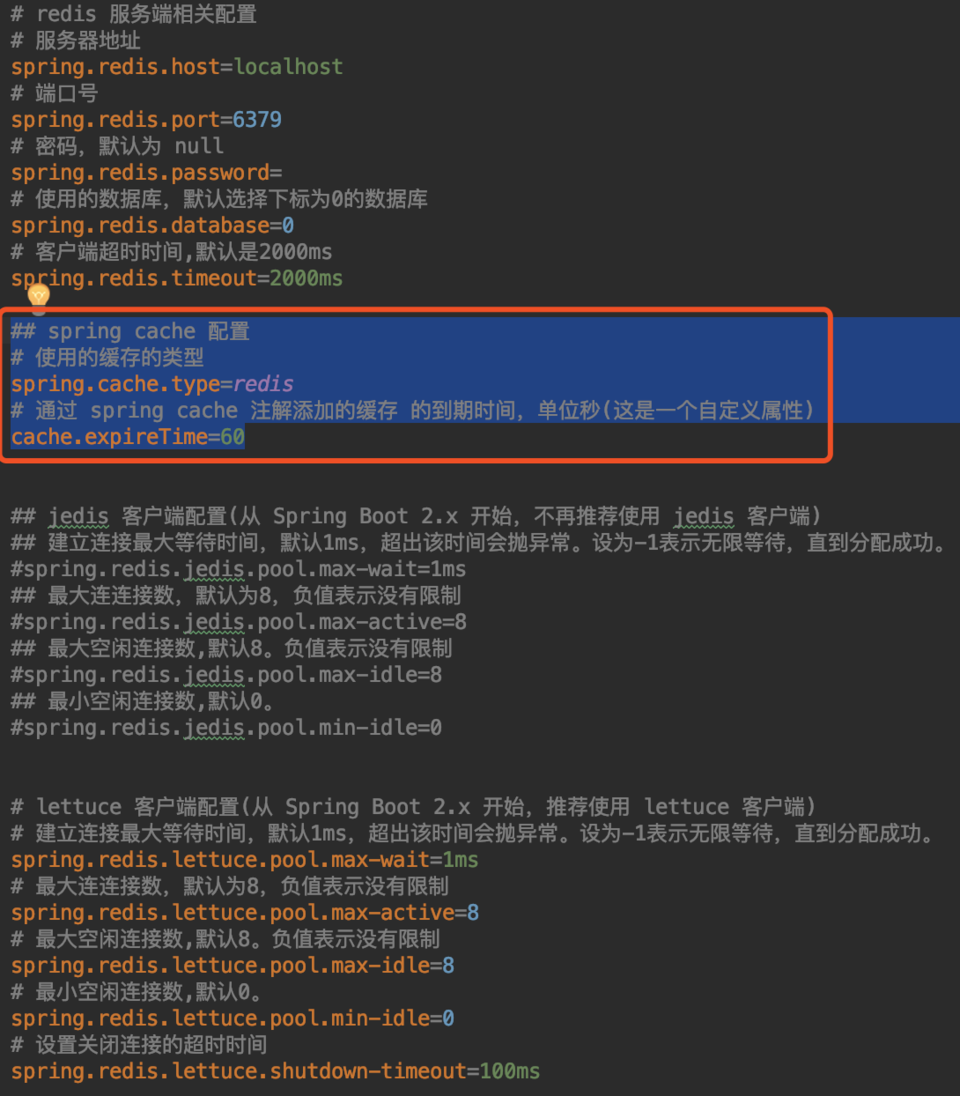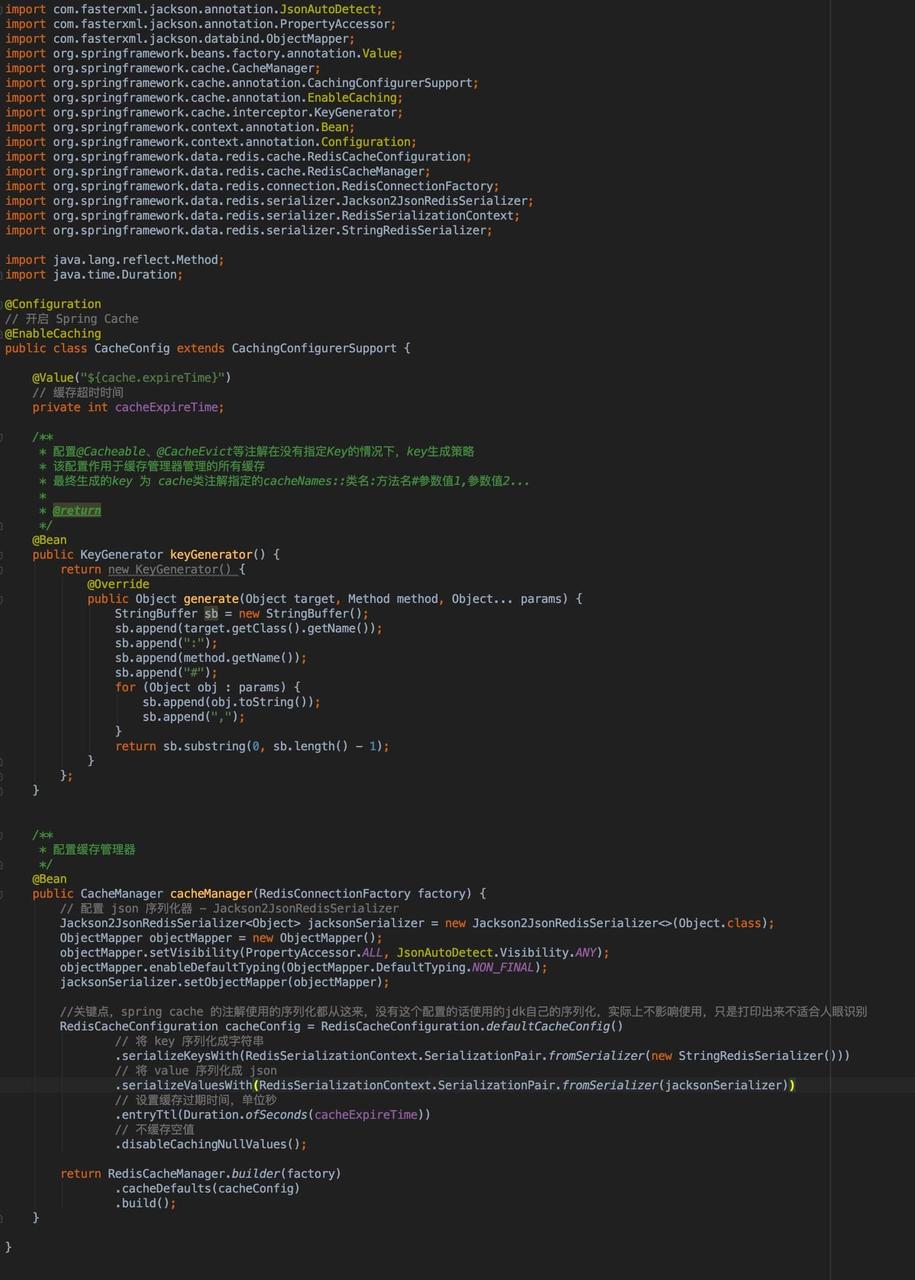Spring Boot 2.0 集成 redis
从 Spring Boot 2.x 开始 Lettuce 已取代 Jedis 成为首选 Redis 的客户端。当然 Spring Boot 2.x 仍然支持 Jedis,并且你可以任意切换客户端。
Lettuce
Lettuce是一个可伸缩的线程安全的 Redis 客户端,支持同步、异步和响应式模式。多个线程可以共享一个连接实例,而不必担心多线程并发问题。它基于优秀 Netty NIO 框架构建,支持 Redis 的高级功能,如 Sentinel、集群、流水线、自动重新连接和 Redis 数据模型
Jedis 在实现上是直接连接的 redis server ,如果在多线程环境下是非线程安全的,这个时候只有使用连接池,为每个 Jedis 实例增加物理连接。
Lettuce 的连接是基于 Netty 的,连接实例 (StatefulRedisConnection) 可以在多个线程间并发访问,应为 StatefulRedisConnection 是线程安全的,所以一个连接实例 (StatefulRedisConnection) 就可以满足多线程环境下的并发访问,当然这个也是可伸缩的设计,一个连接实例不够的情况也可以按需增加连接实例。
Spring Boot 2.0 集成 redis
一般需要4步
- 引入依赖
- 配置 redis
- 自定义 RedisTemplate (推荐)
- 自定义 redis 操作类 (推荐)
引入依赖
<!--redis-->
<dependency>
<groupId>org.springframework.boot</groupId>
<artifactId>spring-boot-starter-data-redis</artifactId>
</dependency>
<!-- lettuce pool 缓存连接池 -->
<dependency>
<groupId>org.apache.commons</groupId>
<artifactId>commons-pool2</artifactId>
</dependency>
<!--jackson-->
<dependency>
<groupId>com.fasterxml.jackson.core</groupId>
<artifactId>jackson-databind</artifactId>
</dependency>
复制代码
- 如果用的是 lettuce 客户端,需要引入 commons-pool2 连接池。
- 如果想用 json 序列化 redis 的 value 值,需要引入 jackson
配置 redis
# redis 服务端相关配置 # 服务器地址 spring.redis.host=localhost # 端口号 spring.redis.port=6379 # 密码,默认为 null spring.redis.password= # 使用的数据库,默认选择下标为0的数据库 spring.redis.database=0 # 客户端超时时间,默认是2000ms spring.redis.timeout=2000ms ## jedis 客户端配置(从 Spring Boot 2.x 开始,不再推荐使用 jedis 客户端) ## 建立连接最大等待时间,默认1ms,超出该时间会抛异常。设为-1表示无限等待,直到分配成功。 #spring.redis.jedis.pool.max-wait=1ms ## 最大连连接数,默认为8,负值表示没有限制 #spring.redis.jedis.pool.max-active=8 ## 最大空闲连接数,默认8。负值表示没有限制 #spring.redis.jedis.pool.max-idle=8 ## 最小空闲连接数,默认0。 #spring.redis.jedis.pool.min-idle=0 # lettuce 客户端配置(从 Spring Boot 2.x 开始,推荐使用 lettuce 客户端) # 建立连接最大等待时间,默认1ms,超出该时间会抛异常。设为-1表示无限等待,直到分配成功。 spring.redis.lettuce.pool.max-wait=1ms # 最大连连接数,默认为8,负值表示没有限制 spring.redis.lettuce.pool.max-active=8 # 最大空闲连接数,默认8。负值表示没有限制 spring.redis.lettuce.pool.max-idle=8 # 最小空闲连接数,默认0。 spring.redis.lettuce.pool.min-idle=0 # 设置关闭连接的超时时间 spring.redis.lettuce.shutdown-timeout=100ms 复制代码
自定义 RedisTemplate
RedisTemplate 是 spring 为我们提供的 redis 操作类,通过它我们可以完成大部分 redis 操作。
只要我们引入了 redis 依赖,并将 redis 的连接信息配置正确,springboot 就会根据我们的配置会给我们生成默认 RedisTemplate。
但是默认生成的 RedisTemplate 有两个地方不是很符合日常开发中的使用习惯
- 默认生成的
RedisTemplate<K, V>接收的key和value为泛型,经常需要类型转换,直接使用不是很方便 - 默认生成的 RedisTemplate 序列化时,使用的是 JdkSerializationRedisSerializer ,存储到 redis 中后,内容为二进制字节,不利于查看原始内容
对于第一个问题,一般习惯将 RedisTemplate<K, V> 改为 RedisTemplate<String, Object> ,即接收的 key 为 String 类型,接收的 value 为 Object 类型 对于第二个问题,一般会把数据序列化为 json 格式,然后存储到 redis 中,序列化成 json 格式还有一个好处就是跨语言,其他语言也可以读取你存储在 redis 中的内容
为了实现上面两个目的,我们需要自定义自己的 RedisTemplate 。
如下,创建一个 config 类,在里面配置 自定义的 RedisTemplate

import com.fasterxml.jackson.annotation.JsonAutoDetect;
import com.fasterxml.jackson.annotation.PropertyAccessor;
import com.fasterxml.jackson.databind.ObjectMapper;
import org.springframework.boot.autoconfigure.AutoConfigureAfter;
import org.springframework.boot.autoconfigure.data.redis.RedisAutoConfiguration;
import org.springframework.context.annotation.Bean;
import org.springframework.context.annotation.Configuration;
import org.springframework.data.redis.connection.RedisConnectionFactory;
import org.springframework.data.redis.core.RedisTemplate;
import org.springframework.data.redis.serializer.Jackson2JsonRedisSerializer;
import org.springframework.data.redis.serializer.StringRedisSerializer;
@Configuration
// 控制配置类的加载顺序,先加载 RedisAutoConfiguration.class 再加载该类,这样才能覆盖默认的 RedisTemplate
@AutoConfigureAfter(RedisAutoConfiguration.class)
public class RedisConfig {
/**
* 自定义 redisTemplate (方法名一定要叫 redisTemplate 因为 @Bean 是根据方法名配置这个bean的name的)
* 默认的 RedisTemplate<K,V> 为泛型,使用时不太方便,自定义为 <String, Object>
* 默认序列化方式为 JdkSerializationRedisSerializer 序列化后的内容不方便阅读,改为序列化成 json
*
* @param redisConnectionFactory
* @return
*/
@Bean
RedisTemplate<String, Object> redisTemplate(RedisConnectionFactory redisConnectionFactory) {
// 配置 json 序列化器 - Jackson2JsonRedisSerializer
Jackson2JsonRedisSerializer jacksonSerializer = new Jackson2JsonRedisSerializer<>(Object.class);
ObjectMapper objectMapper = new ObjectMapper();
objectMapper.setVisibility(PropertyAccessor.ALL, JsonAutoDetect.Visibility.ANY);
objectMapper.enableDefaultTyping(ObjectMapper.DefaultTyping.NON_FINAL);
jacksonSerializer.setObjectMapper(objectMapper);
// 创建并配置自定义 RedisTemplateRedisOperator
RedisTemplate<String, Object> template = new RedisTemplate<>();
template.setConnectionFactory(redisConnectionFactory);
// 将 key 序列化成字符串
template.setKeySerializer(new StringRedisSerializer());
// 将 hash 的 key 序列化成字符串
template.setHashKeySerializer(new StringRedisSerializer());
// 将 value 序列化成 json
template.setValueSerializer(jacksonSerializer);
// 将 hash 的 value 序列化成 json
template.setHashValueSerializer(jacksonSerializer);
template.afterPropertiesSet();
return template;
}
}
复制代码
自定义 Redis 操作类
虽然 RedisTemplate 已经对 redis 的操作进行了一定程度的封装,但是直接使用还是有些不方便,实际开发中,一般会对 RedisTemplate 做近一步封装,形成一个简单、方便使用的Redis 操作类。
当然你也可以选择不封装,看个人喜好。
具体的封装类就不展示了,每个人都有自己的封装方式,没有统一的标准。
Spring Cache
Spring Cache 是 Spring 为缓存场景提供的一套解决方案。通过使用 @CachePut 、 @CacheEvict 、 @Cacheable 等注解实现对缓存的,存储、查询、删除等操作
当我们引入了 spring-boot-starter-data-redis 后,只要在带有 @Configuration 类上使用 @EnableCaching 注解 Spring Cache 就会被“激活”。
Spring Cache 会为我们配置默认的 缓存管理器 和 key生成器 ,但是缓存管理器对缓存的序列化和key生成器生成的key,不易阅读。建议自定义 缓存管理器 和 key生成器
如果用不上 Spring Cache ,可以不用管。
注意:Spring Cache 并不是只能使用 Redis 作为缓存容器,其他例如 MemCache 等缓存中间件,都支持。
配置 Spring Cache

## spring cache 配置 # 使用的缓存的类型 spring.cache.type=redis # 通过 spring cache 注解添加的缓存 的到期时间,单位秒(这是一个自定义属性) cache.expireTime=60 复制代码
最重要的就是指定使用的缓存的类型
另外是一个自定义的变量,后面配置 缓存管理器 会用到
配置缓存管理器和 key 生成器

import com.fasterxml.jackson.annotation.JsonAutoDetect;
import com.fasterxml.jackson.annotation.PropertyAccessor;
import com.fasterxml.jackson.databind.ObjectMapper;
import org.springframework.beans.factory.annotation.Value;
import org.springframework.cache.CacheManager;
import org.springframework.cache.annotation.CachingConfigurerSupport;
import org.springframework.cache.annotation.EnableCaching;
import org.springframework.cache.interceptor.KeyGenerator;
import org.springframework.context.annotation.Bean;
import org.springframework.context.annotation.Configuration;
import org.springframework.data.redis.cache.RedisCacheConfiguration;
import org.springframework.data.redis.cache.RedisCacheManager;
import org.springframework.data.redis.connection.RedisConnectionFactory;
import org.springframework.data.redis.serializer.Jackson2JsonRedisSerializer;
import org.springframework.data.redis.serializer.RedisSerializationContext;
import org.springframework.data.redis.serializer.StringRedisSerializer;
import java.lang.reflect.Method;
import java.time.Duration;
@Configuration
// 开启 Spring Cache
@EnableCaching
public class CacheConfig extends CachingConfigurerSupport {
@Value("${cache.expireTime}")
// 缓存超时时间
private int cacheExpireTime;
/**
* 配置@Cacheable、@CacheEvict等注解在没有指定Key的情况下,key生成策略
* 该配置作用于缓存管理器管理的所有缓存
* 最终生成的key 为 cache类注解指定的cacheNames::类名:方法名#参数值1,参数值2...
*
* @return
*/
@Bean
public KeyGenerator keyGenerator() {
return new KeyGenerator() {
@Override
public Object generate(Object target, Method method, Object... params) {
StringBuffer sb = new StringBuffer();
sb.append(target.getClass().getName());
sb.append(":");
sb.append(method.getName());
sb.append("#");
for (Object obj : params) {
sb.append(obj.toString());
sb.append(",");
}
return sb.substring(0, sb.length() - 1);
}
};
}
/**
* 配置缓存管理器
*/
@Bean
public CacheManager cacheManager(RedisConnectionFactory factory) {
// 配置 json 序列化器 - Jackson2JsonRedisSerializer
Jackson2JsonRedisSerializer<Object> jacksonSerializer = new Jackson2JsonRedisSerializer<>(Object.class);
ObjectMapper objectMapper = new ObjectMapper();
objectMapper.setVisibility(PropertyAccessor.ALL, JsonAutoDetect.Visibility.ANY);
objectMapper.enableDefaultTyping(ObjectMapper.DefaultTyping.NON_FINAL);
jacksonSerializer.setObjectMapper(objectMapper);
//关键点,spring cache 的注解使用的序列化都从这来,没有这个配置的话使用的jdk自己的序列化,实际上不影响使用,只是打印出来不适合人眼识别
RedisCacheConfiguration cacheConfig = RedisCacheConfiguration.defaultCacheConfig()
// 将 key 序列化成字符串
.serializeKeysWith(RedisSerializationContext.SerializationPair.fromSerializer(new StringRedisSerializer()))
// 将 value 序列化成 json
.serializeValuesWith(RedisSerializationContext.SerializationPair.fromSerializer(jacksonSerializer))//value序列化方式
// 设置缓存过期时间,单位秒
.entryTtl(Duration.ofSeconds(cacheExpireTime))
// 不缓存空值
.disableCachingNullValues();
return RedisCacheManager.builder(factory)
.cacheDefaults(cacheConfig)
.build();
}
}
复制代码
总结
网上 Spring Boot 集成 redis 的教程大多都是,将 redis 和 spring cache 一块配置,很容易让人产生误解。
其实 redis 和 spring cache 是两个不同的东西,所以,上面的教程我特意分为了两个配置文件。
你可以只使用 redis 而不使用 spring cache,也可以反过来。
那为什么两者经常放在一起去讨论呢?
原因在于两者也有一定的联系
站在 reids 的角度看,spring cache 提供了一种便捷的操作 reids 的途径,为缓存场景提供了优秀的解决方案。
站在 spring cache 的角度看, reids 提供了一种缓存容器,可以把缓存放在 reids 中。
缓存管理器对 reids 的操作也是通过 redisTemplate 实现的。
- 本文标签: UI 时间 value dist Property Spring Boot java 配置 代码 key build connectionFactory id tk spring js map 多线程 XML Connection 数据模型 服务端 并发 https 安全 Netty json 同步 Word IO 缓存 db 集群 管理 实例 总结 删除 NIO 连接池 端口 线程 IDE App final http cache Sentinel tab redis CTO 开发 core mapper 模型 服务器 数据库 数据 响应式 参数 src bean springboot apache tar
- 版权声明: 本文为互联网转载文章,出处已在文章中说明(部分除外)。如果侵权,请联系本站长删除,谢谢。
- 本文海报: 生成海报一 生成海报二











![[HBLOG]公众号](https://www.liuhaihua.cn/img/qrcode_gzh.jpg)

